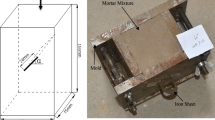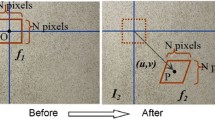Abstract
Surface spalling is a complex failure phenomenon that features crack propagation and detachment of thin pieces of rock near free surfaces, particularly in brittle rock around underground excavations when large in situ stresses are involved. A surface instability apparatus was used to study failure of rock close to a free surface, and damage evolution was monitored by digital image correlation (DIC). Lateral displacement at the free face was used as the feedback signal to control the post-peak response of the specimen. DIC was implemented in order to obtain the incremental displacement fields during the spalling process. Displacement fields were computed in the early stage of loading as well as close to the peak stress. Fracture from the spalling phenomenon was revealed by incremental lateral displacement contours. The axial and lateral displacements suggested that the displacement gradient was uniform in both directions at early loading stages and as the load increased, the free-face effect started to influence the displacements, especially the lateral displacement field. A numerical approach, based on the discrete element method, was developed and validated from element testing. Damage evolution and localization observed in numerical simulations were similar to those observed in experiments. By performing simulations in two- and three-dimensions, it was revealed that the intermediate principal stress and platen–rock interfaces have important effects on simulation of surface spalling.


















Similar content being viewed by others
References
Andersson JC, Martin CD (2009) The Aspo pillar stability experiment: part I—experiment design. Int J Rock Mech Min Sci 46(5):865–878
Bardet JP (1989) Finite element analysis of rockburst as surface instability. Comput Geotech 8(3):177–193
Burgert W, Lippmann H (1981) Models of translatory rock bursting in coal. Int J Rock Mech Min Sci Geomech Abstr 18:285–294
Cai M (2008) Influence of intermediate principal stress on rock fracturing and strength near excavation boundaries- Insight from numerical modeling. Int J Rock Mech Min Sci 45:763–772
Carter BJ, Lajtai EZ, Petukhov A (1991) Primary and remote fracture around underground cavities. Int J Numer Anal Methods Geomech 15(1):21–40
Cundall PA (1971) A computer model for simulating progressive, large-scale movements in blocky rock systems. In: Proceedings of symposium of International Society of rock mechanics, Nancy, 1. No II-8
Cundall PA, Strack ODL (1979) A discrete numerical model for granular assemblies. Geotechnique 29(1):47–65
Daemen JJK, Fairhurst C (1971) Influence of failed rock properties on tunnel stability. In: Proceedings of symposium of 12th U.S. Symposium on rock Mechanics, pp 855–875
Damjanac B, Detournay C, Cundall PA (2015) Application of particle and lattice codes to simulation of hydraulic fracturing. Comput Part Mech. doi:10.1007/s40571-015-0085-0
Diederichs MS, Kaiser PK, Eberhardt E (2004) Damage initiation and propagation in hard rock during tunneling and the influence of near-face stress rotation. Int J Rock Mech Min Sci 41(5):785–812
Drescher A, de Josselin de Jong G (1972) Photoelastic verification of a mechanical model for the flow of a granular material. J Mech Phys Solids 20(5):337–340
Ewy RT, Cook NGW (1990) Deformation and fracture around cylindrical openings in rock-I. Observations and analysis of deformations. Int J Rock Mech Min Sci Geomech Abstr 27(5):387–407
Fakhimi A, Carvalho F, Ishida T, Labuz JF (2002) Simulation of failure around a circular opening in rock. Int J Rock Mech Min Sci 39(4):507–515
Fakhimi A (2004) Application of slightly overlapped circular particles assembly in numerical simulation of rocks with high friction angle. Eng Geol 74(1–2):129–138
Fakhimi A, Villegas T (2007) Application of dimensional analysis in calibration of a discrete element model for rock deformation and fracture. Rock Mech Rock Eng 40(2):193–211
Fakhimi A (2009) A hybrid discrete-finite element model for numerical simulation of geomaterials. Comput Geotech 36(3):386–395
Gay NC (1973) Fracture growth around openings in thick-walled cylinders of rock subjected to hydrostatic compression. Int J Rock Mech Min Sci Geomech Abstr 10(3):209–233
Hazzard JF, Young RP (2000) Simulating acoustic emissions in bonded-particle models of rock. Int J Rock Mech Min Sci 37(5):867–872
Hedayat AR, Pyrak-Nolte LJ, Bobet A (2014) Multi-modal monitoring of slip along frictional discontinuities. Rock Mech Rock Eng 47(5):1575–1587
Huang H, Lecampion B, Detournay EM (2013) Discrete element modeling of tool-rock interaction I: rock cutting. Int J Numer Anal Meth Geomech 37(13):1913–1929
Jacobsson L, Appelquist K, Lindkvist JE (2015) Spalling experiments on large hard rock specimens. Rock Mech Rock Eng 48(4):1485–1503
Kao C-S, Tarokh A, Biolzi L, Labuz JF (2016) Inelastic strain and damage in surface instability tests. Rock Mech Rock Eng 49:401–415
Labuz JF, Bridell JM (1993) Reducing frictional constraint in compression testing through lubrication. Int J Rock Mech Min Sci Geomech Abstr 30(4):451–455
Lajtai EZ, Carter BJ, Duncan EJS (1991) Mapping the state of fracture around cavities. Eng Geol 31:277–289
Lanari M, Fakhimi A (2015) Numerical study of contributions of shock wave and gas penetration toward induced rock damage during blasting. Comp Part Mech 2:197–208
Mack MG, Crouch SL (1990) A dynamic boundary element method for modeling rockbursts. In: Proceedings of 2nd international symposium on rockbursts and seismicity in mines. Balkema, pp 93–99
Makhnenko RY, Labuz JF (2014) Plane strain testing with passive restraint. Rock Mech Rock Eng 47(6):2021–2029
Martin CD, Read RS, Martino JB (1997) Observations of brittle failure around a circular test tunnel. Int J Rock Mech Min Sci 34(7):1065–1073
Martin CD, Christiansson R (2009) Estimating the potential for spalling around a deep nuclear waste repository. Int J Rock Mech Min Sci 46:219–228
Meyer JP, Labuz JF (2013) Linear failure criteria with three principal stresses. Int J Rock Mech Min Sci 60:180–187
Mogi (1967) Effect of the intermediate principal stress on rock failure. J Geophys Res 72(20):5117–5131
Onate E, Zarate F, Miquel J, Santasusana M, Celigueta MA, Arrufat F, Gandikota R, Valiullin K, Ring L (2015) A local constitutive model for the discrete element method. Application to geomaterials and concrete. Comp Part Mech 2:139–160
Ortlepp WD (1983) The mechanism and control of rockbursts. In: Budavari S (ed), Rock mechanics in mining practice. The Southern African Institute of Mining and Metallurgy, Johannesburg, pp 257–281
O’Sullivan C, Wadee MA, Hanley KJ, Barreto D (2013) Use of DEM and elastic stability analysis to explain the influence of intermediate principal stress on shear strength. Geotechnique 63(15):1298–1309
Papamichos E, Labuz JF, Vardoulakis I (1994) A surface instability detection apparatus. Rock Mech Rock Eng 27(1):37–56
Potyondy DO, Cundall PA (1998) Modeling notch-formation mechanisms in the URL mine by test tunnel using bonded assemblies of circular particles. Int J Rock Mech Min Sci 35(4–5):510–511
Potyondy DO, Cundall PA (2004) A bonded-particle model for rock. Int J Rock Mech Min Sci 41(8):1329–1364
Prochazka PP (2004) Application of discrete element methods to fracture mechanics of rockbursts. Eng Fract Mech 71(4–6):601–618
Rice JR (1976) The localization of plastic deformation. In: Koiter WT (ed) Theoretical and applied mechanics. NorthHolland, Amsterdam, pp 202–220
Rojek J (2014) Discrete element thermomechanical modelling of rock cutting with valuation of tool wear. Comp Part Mech 1(1):71–84
Schapermeier E (1979) Formulierung eines Gebirgsschlagkriteriums fur den steinkohlenbergbau mit Hilfe eines Finite-Differenzen-Verfahrens (Formulation of a rockburst criterion for hard coal mining using a finite difference method, In German). Publication IBF, 1979; 83, University of Karlsruhe, Karlsruhe
Schopfer MPJ, Childs C, Manzocchi T (2013) Three dimensional failure envelopes and the brittle-ductile transition. J Geophys Res Solid Earth 118(4):1378–1392
Sharan SK (2010) A finite element perturbation method for the prediction of rockburst. Comput Struct 85:1304–1309
Shou K-J (2010) A three-dimensional hybrid boundary element method for non-linear analysis of a weak plane near an underground excavation. Tunn Undergr Space Tech 15(2):215–226
Tarokh A, Kao C-S, Fakhimi A, Labuz JF (2016) Spalling and brittleness in surface instability failure of rock. Geotechnique 66(2):161–166
Vardoulakis I, Papanastasiou PC (1988) Bifurcation analysis of deep boreholes: I surface instabilities. Int J Numer Anal Meth Geomech 12(4):379–399
Vardoulakis I, Labuz JF, Papamichos E (1991) Surface instability detection apparatus. U.S. patent 5,024,103
Vardoulakis I, Labuz JF, Papamichos E, Tronvoll J (1998) Continuum fracture mechanics of uniaxial compression on brittle materials. Int J Solids Struct 35(31–32):4313–4335
Vermeer PA, De Borst R (1984) Non-associated plasticity for soil, concrete and rock. Heron 29(3):1–65
Zubelewicz A, Mroz Z (1983) Numerical simulation of rock burst processes treated as problems of dynamic instability. Rock Mech Rock Eng 16(4):253–274
Acknowledgments
Partial support was provided by the MSES/Miles Kersten Chair and the Research Council of Norway through project #215667, “Formation reinforcement for wellbore stability and sand control.”
Author information
Authors and Affiliations
Corresponding author
Rights and permissions
About this article
Cite this article
Tarokh, A., Kao, CS., Fakhimi, A. et al. Insights on surface spalling of rock. Comp. Part. Mech. 3, 391–405 (2016). https://doi.org/10.1007/s40571-016-0108-5
Received:
Revised:
Accepted:
Published:
Issue Date:
DOI: https://doi.org/10.1007/s40571-016-0108-5




